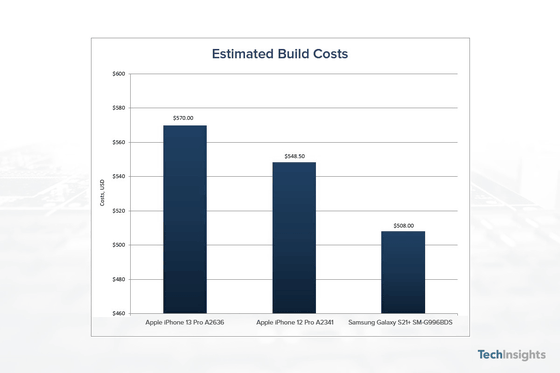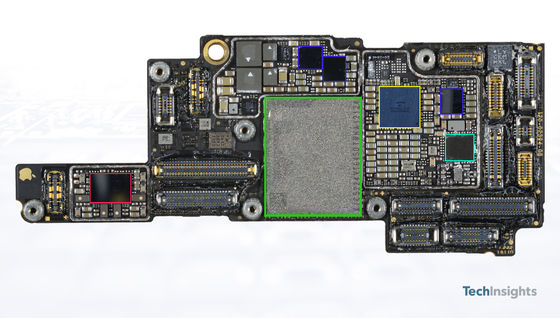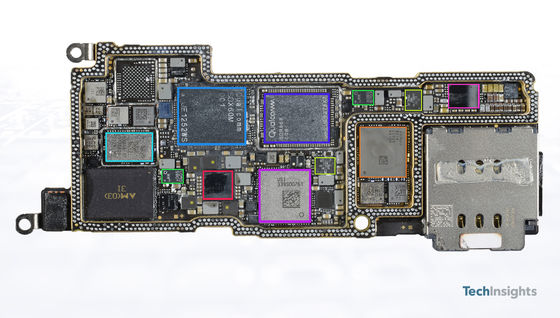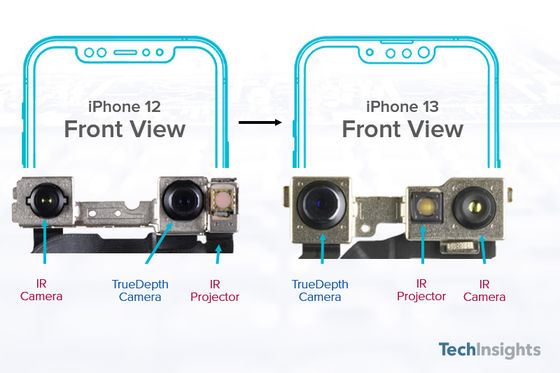Disassembled iPhone 13 Pro separately, estimated manufacturing cost is about 63,000 yen

Apple iPhone 13 Pro Teardown | TechInsights
https://www.techinsights.com/blog/teardown/apple-iphone-13-pro-teardown
iPhone 13 Pro costs Apple $ 21 more to build than iPhone 12 Pro, study finds | AppleInsider
https://appleinsider.com/articles/21/10/04/iphone-13-pro-costs-apple-21-more-to-build-than-iphone-12-pro-study-finds
TechInsights disassembled the iPhone 13 Pro's 256GB model and the iPhone 13's 256GB model. Regarding the manufacturing cost of the iPhone 13 Pro, TechInsights said, 'The manufacturing cost of the iPhone 12 is due to the increase in the price estimation cost of the A15 Bionic, NAND memory and display subsystem, and the cost increase of the main enclosure that affected the total non-electronic cost. It's higher than the Pro. '
The table below is a graph comparing the estimated manufacturing costs of the iPhone 13 Pro (left), iPhone 12 Pro (middle), and Galaxy S21 + 5G (right). In addition, the manufacturing cost of the model of Galaxy S21 + 5G with 256GB of memory is calculated. The manufacturing cost is $ 570 (about 63,000 yen) for the iPhone 13 Pro, $ 548.5 (about 61,000 yen) for the iPhone 13, and $ 508 (about 56,000 yen) for the Galaxy S21 + 5G. The iPhone 13 Pro is $ 28.5 more expensive to manufacture than the iPhone 12 Pro.

TechInsights claims to have identified some of the components within the iPhone 13 Pro. Below is a part of the logic board of the iPhone 13 Pro, the main A15 Bionic chip with 'A15' written in the cyan blue box. The A15 Bionic comes with 6GB of SDRAM. Other components that could be identified are 'Apple APL1098 PMIC' in the blue part, 'NXP Display Port Multiplexer' in the purple part, 'Skyworks SKY58271-19 Front-End Module' in the red part, and 'Skyworks SKY58270-17' in the light blue part. 'Front-End Module', 'Apple / Dialog Semi 338S00770-B0 PMIC' in the green part, 'Apple / Dialog Semi 338S00762-A1 PMIC' in the yellow-green part, 'ST Microelectronics STB601A05 PMIC' in the orange part, 'USI' in the pink part 'Apple U1 UWB Module', 'Texas Instruments TPS65657B0 Display Power Supply' in the yellow part.

'KIOXIA 256 GB NAND Flash' in the green part, 'Apple / Cirrus Logic Audio Codec' in the yellow part, 'NXP SN210 NFC & Secure Element' in the light blue part, 'Apple / Cirrus Logic Audio Amplifier' in the blue part, red part 'Apple / Cirrus Logic Power Conversion'

'Qualcomm Snapdragon X60 5G Modem' in the cyan blue part, 'Qualcomm RF Transceiver' in the blue part, 'USI Wi-Fi / BT Wireless Combo Module' in the purple part, 'Qualcomm PMX60 PMIC' in the red part, 'ST Microelectronics' in the light blue part 'Secure MCU / eSIM', 'Qorvo Envelope Tracker IC (2 pcs, likely)' in the green part, 'Qualcomm Envelope Tracker IC' in the yellow-green part, 'Avago Front-End Module' in the orange part, 'Broadcom' in the pink part Wireless Charging Receiver IC '

The iPhone 13 Pro uses multiple unique chips such as the A15 Bionic, audio codec, and audio amplifier, but Qualcomm's chip is used for high-frequency circuit (RF) design, and KIOXIA, NXP, and STMicroelectronics are also used. , USI, Qorvo, Broadcom and other manufacturers' chips are used.
The A15 Bionic installed in the iPhone 13 Pro and iPhone 13 are both chips with the same model number 'APL1W07', but the SDRAM on the Package on Package (PoP) is 6GB for the iPhone 13 Pro and 4GB for the iPhone 13. The die size of the A15 Bionic is 8.58 mm x 12.55 mm = 107.68 mm2, which is 22.82% larger than the A14 Bionic. The number of GPU cores of A15 Bionic is 5 cores for iPhone 13 Pro and 4 cores for iPhone 13.
The image sensor of the main camera of iPhone 13 is all 12 megapixels. The pixel pitch of the iPhone 13's main camera is 1.7 µm for the wide-angle camera, a slight increase from the 1.4 µm for the iPhone 12, which increases the active array size by 47%. However, the iPhone 12 Pro Max's main camera had a wide-angle camera with a pixel pitch of 1.7 µm, so it's very likely that the iPhone 13 reused the CIS die of the iPhone 12 Pro Max's wide-angle camera, TechInsights said. I'm pointing out.

On the other hand, the wide-angle camera, which is the main camera of the iPhone 13 Pro, has a pixel pitch of 1.9 µm, which is an increase from the 1.4 µm of the iPhone 12 Pro. As a result, the active array size has increased by 84%, making the camera more resistant to shooting in dark places. The wide-angle camera CIS die is likely to be used in the iPhone 13 Pro Max as well, making it the largest CIS die in the iPhone 13 series. The iPhone 13 and iPhone 13 Pro ultra-wide-angle cameras and the iPhone 13 Pro telescope all use the same die, with a pixel pitch of 1.0 µm.
In the TrueDepth camera of the iPhone 13 series, the infrared (IR) camera has moved from the left side to the right side of the module, but there is no change in the die size of the camera module, etc., and the movement is due to integration with the IR projector module. matter.

The 'Qorvo QM81030' was also installed in the iPhone 12 series, and the same model number is used. However, when taking an X-ray photograph, the structure inside seems to be slightly different.

Related Posts:







